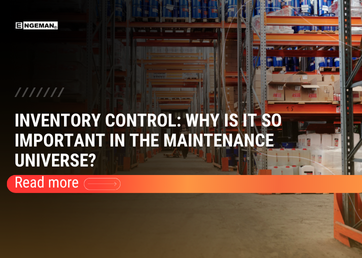Contents
What are the KPIs for maintenance?
Maintenance KPIs are management instruments that measure a company’s results. In this way, it is possible to follow everything that happens in your management. Also, know that performance indicators display how positive or negative each activity is.
In a very simple way: they generate numerical values, which help to measure the effectiveness of the work.
What is the importance of maintenance KPIs?
In the case of maintenance, maintenance KPIs provide important data, such as:
- distribution of activities by type of corrective, preventive, or predictive maintenance;
- materials stocks and spare parts policy ;
- maintenance planning;
- employees training and qualification;
- operating results;
- maintenance downtimes.
All this information optimizes the analysis of the situation and saves you time. In addition, it is also possible to save money, as you avoid mistakes and quick decisions.
How do you choose the right KPI?
Selecting the right KPI is a difficult task. Each management has its particularities, right? Well, then, a strategy that works in the neighboring company may not present good results for you.
Therefore, you must analyze the available inputs very well and what your organization’s goals are.
A quality indicator needs to have:
- objectivity and clarity to convey information, not being complex or difficult to analyze;
- real results, which are consistent with the company’s activities;
- accuracy to avoid duplication of data;
- representativeness to show something tangible and important for the business;
- uniqueness, that is, having an established rule or measure;
- to reach and signal the causes of problems;
- challenges that motivate team engagement.
By using these requirements, you will find it easy to find a pattern in your decisions, always aiming at the continuous improvement of maintenance processes.
In which departments should I apply them?
After knowing the maintenance KPIs advantages, you must be wondering what the best areas are to introduce them, right? There is no rule for this. You need to analyze the activities performed in each department in order to find the best solution.
There is also advice that will help you on your journey. A good strategy is to distinguish them by area, providing only information that is relevant.
The maintenance department, for example, does not need to know the number of hits on the company’s website, just as the number of parts changed is not useful for the marketing area.
At these times, the excess of data can hinder the understanding of employees. So, stay tuned.
What are the best maintenance KPIs?
Now, it’s time for you to discover the most important examples of maintenance. See them below:
Availability
Automation has broken production barriers. Nowadays, a company’s departments are all interconnected and monitored in real-time. So, all the equipment is necessary for the operation of the entire system in many cases.
Availability reveals the probability that a machine will be accessible and functional at any given time. It ensures the fulfillment of production goals and helps with the monitoring of other KPIs.
Maintenance Cost
The financial issue is also very essential for any type of business. Expenses related to maintenance cannot exceed the amounts stipulated by the business budget. Generally, maintenance cost is the basic sum of material resources, spare parts, payment of employees, and intervention expenses.
When management has more in-depth knowledge and is well-trained, it is also possible to deal with opportunity costs, production losses, and own costs.
However, don’t just use this performance indicator to analyze your performance and generate maintenance indicator reports. Relying just on financial figures is not always a good idea, so do a global analysis before taking action.
Mean Time Between Failure (MTBF)
Problems and failures happen in very well-prepared companies. Therefore, it is essential that you know how often they happen. With this information in hand, you create a preventive, corrective, and predictive maintenance plan.
MTBF is the KPI represented by the average time between the occurrence of one failure and the next. Understand better with the following example:
One machine works in 3 shifts, totaling 24 hours of availability (1,440 minutes). During this time, there are 4 failures, with a total time of 120 minutes of downtime. So:
MTTR= (Uptime – Downtime) / Number of Failures
MTTR= (1440 – 120) / 4 = 330 minutes
It is then concluded that a failure happens every 330 minutes.
Mean Time to Repair – MTTR
MTTR is very important in the day-to-day work of a maintenance manager. This is because it points out the time it takes for the team to repair a failure. In addition, the MTTR comprises all the activities involved in the repair, whether they are from the purchasing team or the laboratory.
Also know that this KPI helps in inventory management, as it indicates the amount of spare parts needed to maintain the continuous production flow. Labor planning is also facilitated, as it is possible to find out the ideal number of employees available for scheduled executions.
A direct consequence of the MTTR application is related to the reduction of production downtime and maintenance costs.
Reliability
Industrial systems are usually large and complex. In this way, employees must be safe to work, since the slightest carelessness can cause accidents and financial losses.
Reliability represents the probability that a piece of equipment will function correctly for a certain period under normal conditions. When this KPI is low, business productivity is put at risk. Therefore, you should use it with great caution.
It also gives the degree of reliability of each machine, helping to manage employees’ time off and perform emergency maintenance.
Backlog
Maintenance backlog is a time indicator that is used to measure the activities that are pending completion. This maintenance KPI in the industry refers to the time a work order needs to wait for it to be resolved.
We can also define it as the time at which the team responsible for the work needs to complete its activities. The correct analysis of the backlog helps the maintenance manager know the operational reality of his entire team and, from this knowledge, make more assertive decisions.
Given its importance, then, how do you calculate the maintenance backlog? Its calculation can be done using the Backlog = Total Backlog Workhours / Total Workteam Daily Productive Hours formula, where the first one refers to the number of man-hours estimated for the execution of work orders (pending, scheduled, and in execution) and the second refers to the number of man-hours available to execute them. As it is a time indicator, the backlog is calculated in minutes, hours, days, weeks, etc.
Benchmarking
Companies that have the best practices aimed at maintenance, if well managed, should provide a significant reduction in their production or service costs. For this, maintenance must consider the importance of its role; the organization’s need for it, and the performance of this activity in its competitors.
It is important to seek information about what makes successful companies and try to find the best; this is possible through benchmarking, which is nothing more than a process of improving performance by searching, understanding, and adopting practices that are found inside and outside organizations.
Before applying benchmarking, you must have well-consolidated criteria, in order to extract only what is favorable for your business.
There are, in fact, several issues that influence the work routine of a maintenance supervisor. In any case, it is necessary to stay tuned to market news and apply technologies and strategies that represent the most modern.
At these times, maintenance key performance indicators (KPIs) expand your field of vision, providing relevant information in real-time. As much as they are represented by simple numbers, they facilitate the understanding of relationships in your company and help reduce costs and increase safety at work.
Therefore, make a careful analysis to find those that best suit your profile and discover good opportunities to prove value in the institution.
Follow Engeman’s page on social networks and always stay well informed. We are on Instagram!




